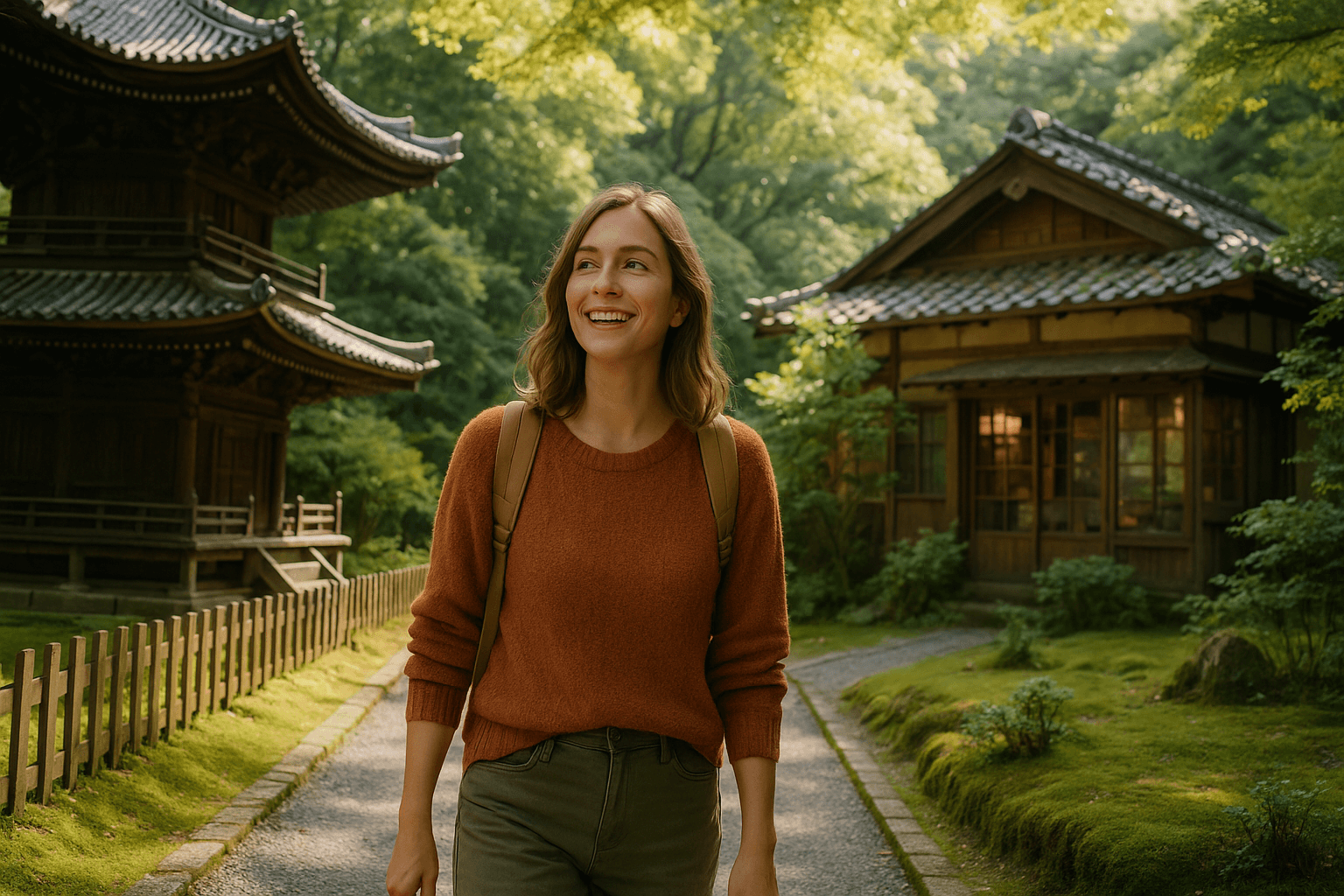When most travelers think of Kyoto, they picture the dazzling Golden Pavilion (Kinkaku-ji), the iconic Fushimi Inari Shrine with its thousand red torii gates, or the historic streets of Gion. While these sites are spectacular, they often attract heavy crowds. But Kyoto’s true magic lies beyond the tourist hotspots, in quiet gardens, small neighborhood temples, and tucked-away cafés where tradition and modern life blend seamlessly.
If you’re looking to experience Kyoto like a local, this guide to Kyoto hidden gems will take you off the beaten path and into a world of authenticity. Let’s uncover secret temples, cozy cafés, and experiences that will make your trip unforgettable.
- Honen-in Temple: A Hidden Spiritual Retreat
- Shinnyo-do Temple: Autumn’s Secret Sanctuary
- Gio-ji Temple: Moss Garden Wonderland
- Otagi Nenbutsu-ji: Quirky Stone Statues
- Murin-an Garden: Meiji-Era Beauty
- Café Bibliotic Hello!: Books and Coffee
- Weekenders Coffee: Third-Wave Hideout
- How to Reach Them and What Makes Them Unique
- Food and Cultural Experiences Nearby
- Tips for Exploring Off-the-Beaten-Path Kyoto
- Conclusion
Honen-in Temple: A Hidden Spiritual Retreat
Why It’s Special
Nestled in the foothills of the Higashiyama mountains, Honen-in is often overlooked by travelers rushing between Ginkaku-ji (Silver Pavilion) and the Philosopher’s Path. This serene temple is dedicated to Honen, the founder of the Pure Land sect of Buddhism.
What sets Honen-in apart are its two sand mounds at the entrance, symbolizing water purification. Seasonal gardens, mossy grounds, and occasional art exhibits make it a place of quiet reflection far from the tourist crowds.
Access
- Location: Near the Philosopher’s Path, Higashiyama.
- Nearest station: Bus to Ginkaku-ji-mae stop, then a 10-minute walk.
💡 Tip: Visit in the morning when the air is crisp and the grounds are nearly empty.
Shinnyo-do Temple: Autumn’s Secret Sanctuary
Why It’s Special
Known officially as Shinsho Gokuraku-ji, Shinnyo-do Temple is one of Kyoto’s best-kept secrets, especially in autumn. While tourists crowd Kiyomizu-dera, this hillside temple boasts breathtaking maple trees that turn fiery red in November.
Its expansive grounds, pagoda, and peaceful atmosphere allow visitors to truly savor the season. Unlike other temples, photography is welcome, making it a favorite spot for local photographers.
Access
- Location: North of Heian Shrine.
- Nearest station: Keihan Demachiyanagi Station, then a 20-minute walk or short taxi ride.
💡 Tip: Combine a visit with nearby Yoshida Shrine for a quiet, spiritual afternoon.
Gio-ji Temple: Moss Garden Wonderland
Why It’s Special
In the Arashiyama area—famous for its bamboo grove—there lies a tiny temple that feels worlds apart: Gio-ji. Dedicated to a tragic love story between a dancer and the warlord Taira no Kiyomori, the temple is cloaked in romance and melancholy.
The highlight is its moss garden, where dozens of moss species create a lush green carpet beneath maple trees. Sunlight filters through, creating a dreamlike atmosphere that rivals Kyoto’s more famous moss temple (Saiho-ji), but without the restrictive reservations.
Access
- Location: Arashiyama, near Adashino Nenbutsu-ji.
- Nearest station: Arashiyama Station (Hankyu or Keifuku lines), then a 20-minute walk or short taxi ride.
💡 Tip: Visit in late afternoon when the moss glows in soft light.
Otagi Nenbutsu-ji: Quirky Stone Statues
Why It’s Special
If you’re up for a longer walk from Arashiyama’s bamboo grove, Otagi Nenbutsu-ji is worth the detour. This small temple is famous for its 1,200 unique rakan (disciples of Buddha) statues, each carved by different amateur sculptors.
The statues are quirky and expressive—some smile, some laugh, others even hold cameras or musical instruments. It’s a mix of spirituality and humor, embodying the idea that Buddhism embraces all aspects of life.
Access
- Location: Arashiyama outskirts.
- Nearest station: Saga-Arashiyama Station (JR). From there, a 30-minute walk or short bus ride.
💡 Tip: Combine Gio-ji and Otagi Nenbutsu-ji for a hidden temple-hopping adventure.
Murin-an Garden: Meiji-Era Beauty
Why It’s Special
Created in the late 19th century by a Meiji-era statesman, Murin-an Garden blends Japanese tradition with Western influences. Its design emphasizes flowing water, natural landscapes, and seasonal flowers.
Unlike larger gardens, Murin-an is intimate, with a teahouse where visitors can sit and enjoy matcha while overlooking the pond and waterfall. It’s a perfect example of Kyoto’s ability to blend history, nature, and modern life.
Access
- Location: Near Nanzen-ji and Heian Shrine.
- Nearest station: Keage Station (Tozai Subway Line), 10-minute walk.
💡 Tip: Visit during cherry blossom season—its smaller crowds make it a more tranquil hanami spot.
Café Bibliotic Hello!: Books and Coffee
Why It’s Special
For a break from temples, head to one of Kyoto’s most atmospheric cafés. Café Bibliotic Hello! combines rustic charm with intellectual vibes. Imagine sipping coffee surrounded by tall bookshelves, exposed wooden beams, and cozy lighting.
The café serves excellent espresso, homemade bread, and cakes. It’s a favorite hangout for students, artists, and travelers seeking a slower pace.
Access
- Location: Between Kyoto Imperial Palace and Nijo Castle.
- Nearest station: Karasuma Oike Station, 10-minute walk.
💡 Tip: Perfect for journaling, reading, or simply recharging your energy.
Weekenders Coffee: Third-Wave Hideout
Why It’s Special
Hidden in a quiet parking lot near Karasuma, Weekenders Coffee embodies Kyoto’s minimalist aesthetic. With a focus on specialty beans and hand-poured brews, this café is a pilgrimage site for coffee lovers.
The space is small and intimate, but the quality of coffee rivals the best in Japan. Its hidden location adds to the thrill—you’ll feel like you’ve discovered a secret café known only to locals.
Access
- Location: Near Nishiki Market.
- Nearest station: Karasuma Station, 5-minute walk.
💡 Tip: Try their seasonal single-origin pour-over.
How to Reach Them and What Makes Them Unique
Exploring Kyoto’s hidden gems requires a bit more planning than hopping on the tourist trail, but the effort pays off.
- Use buses and taxis for temples: Many lesser-known temples like Shinnyo-do and Otagi Nenbutsu-ji are best accessed by bus or a short taxi ride from main stations.
- Walk the Philosopher’s Path: Combine Honen-in with Ginkaku-ji for a mix of famous and hidden.
- Arashiyama backstreets: Skip the crowded bamboo grove and wander deeper into the hills for Gio-ji and Otagi Nenbutsu-ji.
- Central Kyoto cafés: Weekenders Coffee and Café Bibliotic Hello! are both easily reached from subway stations and make for relaxing breaks between sightseeing.
What makes these places unique is their intimacy. Unlike Kyoto’s big-name attractions, these hidden gems invite slow exploration, quiet reflection, and a deeper connection with the city.
Food and Cultural Experiences Nearby
No trip to Kyoto is complete without food. Luckily, these off-the-beaten-path spots also come with delicious cultural experiences.
- Near Honen-in: Try traditional Japanese sweets (wagashi) at local tea shops on the Philosopher’s Path.
- Shinnyo-do area: Stop by local soba noodle restaurants near Demachiyanagi.
- Arashiyama temples: Enjoy yudofu (tofu hot pot), a Buddhist specialty, in quiet temple-side eateries.
- Murin-an area: Dine at kaiseki restaurants near Nanzen-ji for an upscale experience.
- Central Kyoto cafés: Pair specialty coffee with a stroll through Nishiki Market, where you can sample street food like takoyaki, matcha sweets, and grilled skewers.
Cultural highlights include:
- Tea ceremonies: Many temples and gardens offer seasonal tea experiences.
- Craft shops: Arashiyama and central Kyoto feature traditional crafts like fans, ceramics, and textiles.
- Local festivals: If you’re visiting in summer, smaller neighborhood festivals offer authentic matsuri vibes without the massive crowds.
Tips for Exploring Off-the-Beaten-Path Kyoto
- Go early or late: Even hidden spots can get busier midday.
- Wear comfortable shoes: Narrow alleys and hillside temples mean lots of walking.
- Bring cash: Some small temples and cafés don’t accept credit cards.
- Respect the quiet: Many of these temples are still active places of worship.
- Use maps but embrace wandering: Kyoto’s charm often lies in the unexpected discoveries along the way.
- Balance famous and hidden: Pair a big-name site with a nearby secret spot for the best of both worlds.
Conclusion
Kyoto is a city of contrasts—world-famous landmarks stand alongside hidden treasures that remain unknown to most visitors. By venturing off the beaten path, you’ll find Kyoto hidden gems like Honen-in’s mossy quiet, Shinnyo-do’s autumn blaze, Gio-ji’s fairytale garden, and cafés like Bibliotic Hello! where modern Kyoto thrives.
These secret temples and cozy cafés invite you to slow down, sip tea, breathe in the scent of moss, and connect with Kyoto’s timeless spirit. So next time you’re planning your itinerary, don’t just follow the crowds. Step aside, and let Kyoto reveal its secrets.

